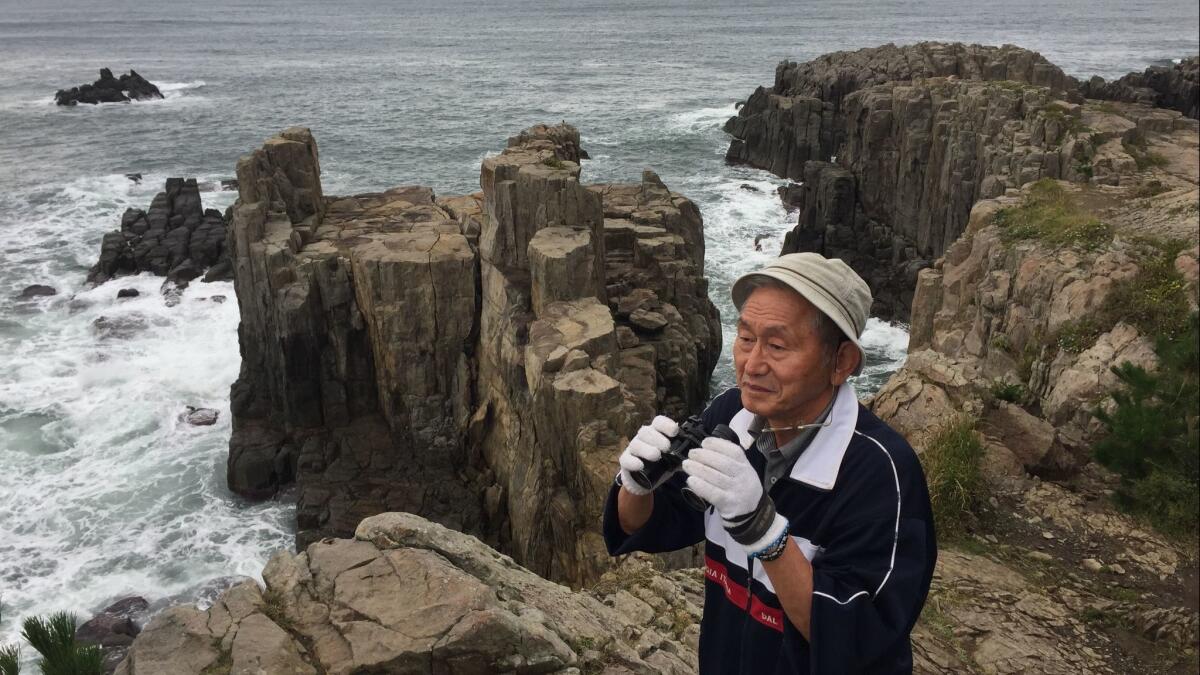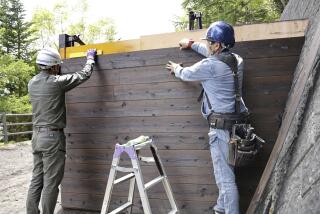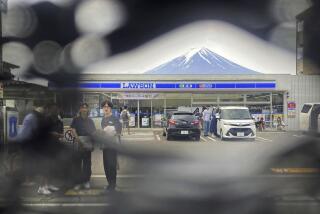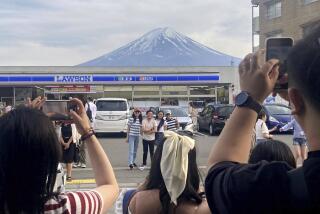At Japan’s suicide cliffs, he’s walked more than 600 people back from the edge

Reporting from FUKUI, JAPAN — Almost no one jumps on rainy days.
They jump when the sun returns and the masses step outside, reminding them of their misery. They jump during financial crises and in the early spring, when Japanese schools open and the pressures of life converge.
Yukio Shige’s routine, though, is the same regardless of the weather.
Nearly every day, he clambers across the high basalt columns of the Tojinbo cliffs, the Sea of Japan thrashing 80 feet below. He peers into binoculars, seeking hunched figures on distant rocks, ready to talk them down.
In 15 years, he’s walked 609 people back from the edge.
“The way I save people, it’s like I’m seeing a friend,” said Shige, 73, a retired policeman with a floppy fishing hat and a gentle demeanor. “It’s not exciting or anything. I’m like, ‘Hey, how are you doing?’ These people are asking for help. They’re just waiting for someone to speak with them.”
Japan’s suicide rate is among the highest in the developed world. In 2016, there were 17.3 suicides for every 100,000 people, second only to South Korea among major industrialized nations (the U.S. figure is 13.5). As in most places, the majority of victims are men. The most common method is hanging, unlike in the U.S., where it is firearms. Among people age 15 to 39 in Japan, suicide is the leading cause of death — claiming more lives than cancer and accidents combined.
Those statistics are a marked improvement, thanks to a strengthening economy and prevention efforts by the government. About 22,000 people killed themselves in Japan in 2016, the lowest number in 22 years, down from about 33,000 a year in the late 1990s following an economic crash.
Outside of Japan, media depictions of suicide in the country frequently involve concepts of honor and disgrace, from 12th century samurai who committed seppuku — a ritualized form of self-disembowelment — to World War II kamikaze pilots who deliberately crashed into Allied ships.
Yet in modern Japanese life, it’s largely viewed in less romanticized terms: a public health crisis driven by widespread depression, family problems, unemployment and pressure at work and school. Tokyo introduced a basic law for suicide countermeasures in 2007, and broadened that law with new, more holistic guidelines a decade later.
The Japanese government is “dealing with suicide on a legal, social and cultural level,” said Yutaka Motohashi, a professor and suicide researcher at the Kyoto Prefectural University of Medicine.
He said that officials, rather than simply pumping money into researching depression, are attempting to address suicide’s underlying causes. They’re opening suicide hotlines, improving access to counseling, monitoring websites that might promote suicide cults, and tweaking employment laws in a drive to reduce the number of working hours per week.
Although most suicides in Japan take place at home, some occur in “suicide hot spots” — bridges, cliffs, gorges, skyscrapers. Experts say Japan has 50 of them, including the Aokigahara forest, the infamous “Sea of Trees” at the base of Mt. Fuji.
In January, YouTube star Logan Paul sparked a public backlash when he posted a video in which he discovers a body hanging in the forest and laughs. Paul has since apologized.
Another popular spot is the Tojinbo cliffs, about 200 miles west of Tokyo. Legend has it they’re named after a licentious monk who died when a rival in courtship pushed him off the precipice. They stretch on for more than half a mile, their wave-eroded crags reaching like bony fingers into the sea.
Shige worked as a police officer for 42 years, and at Tojinbo, his final posting, he frequently had to remove corpses from the waves. In 2003, he spotted an elderly couple on a bench and approached them. They said they owned a bar in Tokyo and were deeply in debt; they planned to jump at sunset.
Shige called his colleagues, who took them to the local welfare bureau. But the police then sent the couple away, and five days later, they hanged themselves in Niigata, a neighboring prefecture.
Shaken, Shige set up a nonprofit to patrol the cliffs. He now has about 20 volunteers, who keep nearly constant watch during daylight hours. “The reason we patrol as individuals is, if you do it in pairs, the person feels suspicious and hides away,” he said. “People feel safer if it’s a one-on-one conversation.”
Shige recently acquired a drone, which can surveil the cliffs at great speed.
He can’t talk everyone down. Last year, 10 people killed themselves on the cliffs; in 2016, it was 14, and in 2015, it was 12.
Leaving the cliffs one day, Shige noticed a black bag on the ground and feared he had arrived there too late. He approached it carefully and unzipped it, looking for a message, or an heirloom, or personal belongings.
“Maybe it was a bag that someone wanted to leave,” he said.
But the bag, inexplicably, was full of sand. He sighed in relief and walked on.
Fences, nets and other barriers have stopped potential jumpers at suicide hot spots in the West, such as the Prince Edward Viaduct in Canada. Shige has pushed for similar protections, but officials have rejected the idea at Tojinbo, saying they’d hurt tourism. Authorities have, however, installed outdoor lighting to dissuade jumpers after dark.
The jumpers, Shige said, represent a cross-section of Japan’s most vulnerable demographics: the homeless, the elderly, schoolchildren under academic duress. They take the train to Fukui prefecture, then a bus to the cliffs. They carry very little cash — “because if you’re going to heaven, you don’t need money,” he said. They sit alone for hours along the precipice, until the sun falls and the crowds dwindle.
As he described a typical case, it became clear that the smallest details have stayed with him. Last Aug. 31, at 6:20 p.m., Shige noticed a 17-year-old girl sitting on the edge of the cliff, lost in contemplation. Shige brought her to his headquarters, a small office nearby, and engaged her in conversation. Her parents were pressuring her to succeed, she told him, and she felt inadequate.
“School started yesterday, and I didn’t do my homework, so I was embarrassed,” he said she told him. So instead of going to school that morning, she took a train and a bus to the cliffs — a two-hour trip from her home in Shiga prefecture.
She was the 23rd of 28 people he saved in 2017.
Shige called her parents, who came to pick her up. “We asked, ‘Which is more important, her life or graduation?’ And we handed her over.”
For more news from Asia, follow @JRKaiman on Twitter
More to Read
Sign up for Essential California
The most important California stories and recommendations in your inbox every morning.
You may occasionally receive promotional content from the Los Angeles Times.










